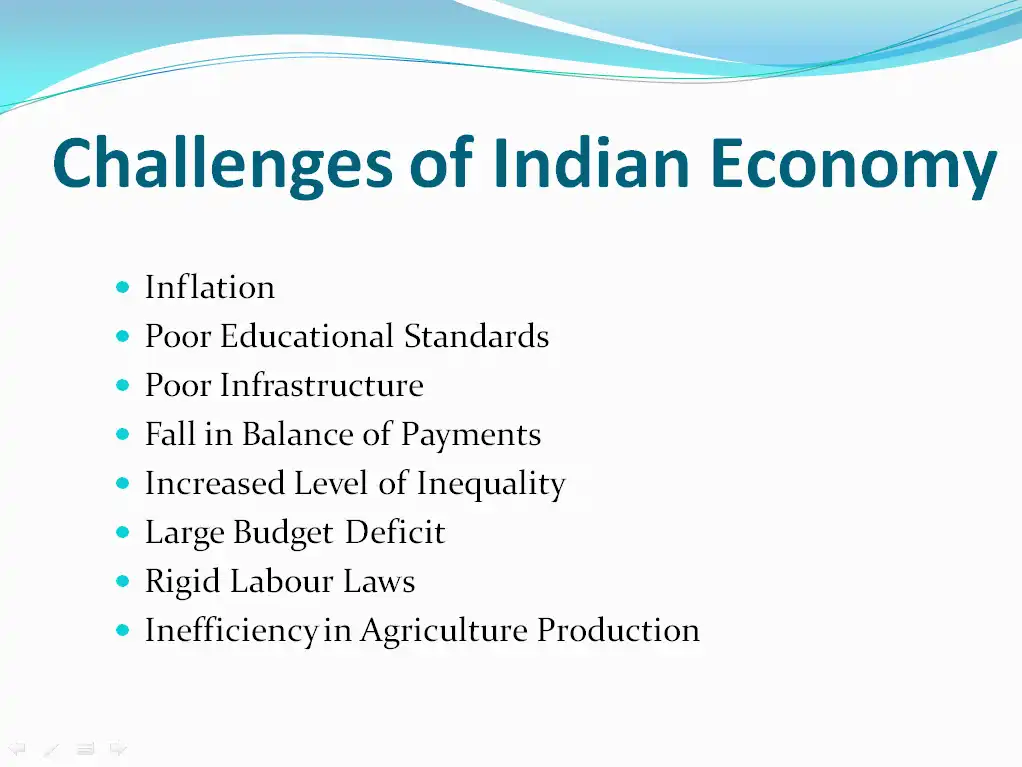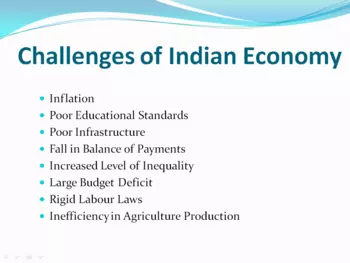Table of Contents:-
- Challenges of Indian Economy
- Importance of Indian Economy
Challenges of Indian Economy
The Indian economy faces a wide array of challenges that require focused attention and strategic action. To gain a thorough understanding of the issues of challenges of Indian economy, it is essential to delve into their complexities and explore possible solutions. These economic challenges in India are multifaceted and require thorough analysis, along with creative approaches to address them effectively.
The year 1991 proved to be a landmark, as the economy of India has undergone several transformations, such as open market liberalisation, more freedom in the arena of trading and more expenditure on infrastructure development.
Despite these achievements several hurdles and issues are standing in front of the Indian economy, some of the challenges of Indian economy are as follows:
1) Inflation
Inflation in the arena of food and property prices is an intensifying issue which is geared up with rising salaries. The present inflation structure is 6.4 per cent. Inflation is a grave issue despite an economic slump. Inflation adversely affects the production volume because the expectation of rising prices along with rising costs of inputs brings uncertainty.
This reduces production. The propensity to save declines when prices rise rapidly because more money is needed to buy goods and services. Reduced saving adversely affects capital formation and investment. As a result, production is hindered. Inflation involves the sacrificing of the advantages of division of labour and international specialization. It adversely affects the country’s balance of payments.
When prices rise more rapidly in the home country than in foreign countries, domestic products become more expensive compared to foreign products. This tends to boost imports and reduce exports, making the balance of payments unfavourable for the country.
2) Poor Educational Standards
Though India has the advantage of having many people who can speak English (which proves to be an asset in call centres and MNCs), the level of illiteracy in India reveals sorry figures. Over fifty per cent of women in India fail to acquire an education. Illiteracy stands as a hurdle in the way of economic development of the nations as the workers fail to develop the necessary skills.
3) Poor Infrastructure
Most Indian households lack basic facilities, such as a sewage system, clean drinking water, etc. The added disadvantage is the inability to deliver foodgrains in time, which is responsible for the rotting of 40 per cent of foodgrains and is smashing the Indian economy.
4) Fall in Balance of Payments
Even though India has an enormous foreign exchange base, the soaring economic growth is depleting its accounts. However, India is experiencing more imports in comparison to exports.
This indicates that what India needs to make up for this loss in finance is the continuous inflow of cash. Though, there is always a scarcity of funds, yet, there is constant uncertainty that the value of the rupee might experience more fall. Hence, what is needed is economic stability and the promotion of exports.
5) Increased Level of Inequality
The economic growth was supposed to pull out the poor section from below the poverty line. Yet, economic growth has widened the financial gaps between different sections.
As mainly skilled and affluent classes were at an advantage, several poor people in rural areas still did not experience any significant benefit from the economic growth. Above 78 million families lack basic amenities, such as electricity. About 33 per cent of the population, i.e., nearly 268 million people are unable to earn even one dollar in a day.
6) Large Budget Deficit
Among developing countries, India is facing a major difficulty of scarcity in budget. The scarcity of budget is about 8% of GDP if subsidies are not included. However, in the recent past, these deficiencies have lessened to some extent. However, there are still chances of investing somewhat in public sectors, like, education and health.
7) Rigid Labour Laws
Sometimes the severity of labour laws stands as a significant hurdle in the financial growth of the country. For example, those organisations which have more than a hundred employees, have to take due permission from the government while expelling any one of them. Overseas investments are also discouraged by these laws. As trade unions have politically strong bases, government organizations avoid muddling with politically susceptible labour laws.
8) Inefficiency in Agriculture Production
Though, more than 51 per cent of workers are engaged in agriculture, yet, the output is 17.4 per cent of the economy. Thus, agriculture proves to be a very non-productive sector with a very slow reform rate.

Importance of Indian Economy
The following points describe the importance of the Indian economy:
1) Rapidly Rising Economy
The Indian economy is one of the rapidly rising economies in the world. In the past few years, it has drawn the interest of overseas investors. The scope of economic reforms which were started in 1991 has widened and helped in bringing about significant gains.
Firstly, this can be seen in the form of a progressive rise in India’s place in the global economy, which was evident through its widening influence on global organisations, such as the G8 and G20 and its ability to negotiate in the arena of free trade, such as EU, ASEAN.
Secondly, it can be seen through its enhanced economic competence and ability to take up “the best practices” for manufacturing products and services. Thirdly, the power of India to acquire a position among the top ten world destinations for investment from 2007-2008 has enabled it to draw U.S. $195 billion in FDI and U.S. $97 billion in FII, in the past five years.
In 2013. India appeared in the tenth position in terms of the largest GDP in the world with a net worth of 1.9 trillion U.S. Dollars. During the present Five Years Plan. i.e. 2012 to 2017, the government has aimed to attain an 8 per cent rise in GDP. It is important to sustain its economy gracefully despite the global crisis of falling prices in the Eurozone in the past few years.
2) High Demographic Dividend
India is characterised by a high demographic dividend. With the rise of working-age people, the economy of the country increases, it is called a demographic dividend. In India, youth (15-34 years) is largely involved in the working-age population (15-59).
Due to the large contribution of youth to the working population, India can grow exponentially. Several multinational companies prefer to expand their businesses in India because of the talent and knowledge present here.
By 2020, the average age of an Indian would be 29 years as compared to China and the U.S. (37 years), Japan (48) and Western Europe (45).
3) Strong Consumer Market
In the first quarter of 2016, consumer spending was about 16668.88 billion. Unfortunately, in the second quarter of 2016, it dropped to 16055.27 billion. It is also estimated that out of every ten Indians, nine would belong to the international middle-class group’, by having daily expenses of U.S. $10-$100.
4) Rising Trends in FDI Flow
The inclination of Foreign Direct Investment (FDI) to rise is making India the most sought place for international investors. Some of the most valuable assets of the Indian economy are industries such as IT, telecommunication, chemicals, auto parts, clothing, medicines and jewellery.
You May Also like:-
Process of Environmental Analysis
Public sector in Indian economy
Problems related to public sector in Indian economy
Importance of business environment
Corporate Social Responsibility
Problems related to public sector in Indian economy
Public sector in Indian economy
